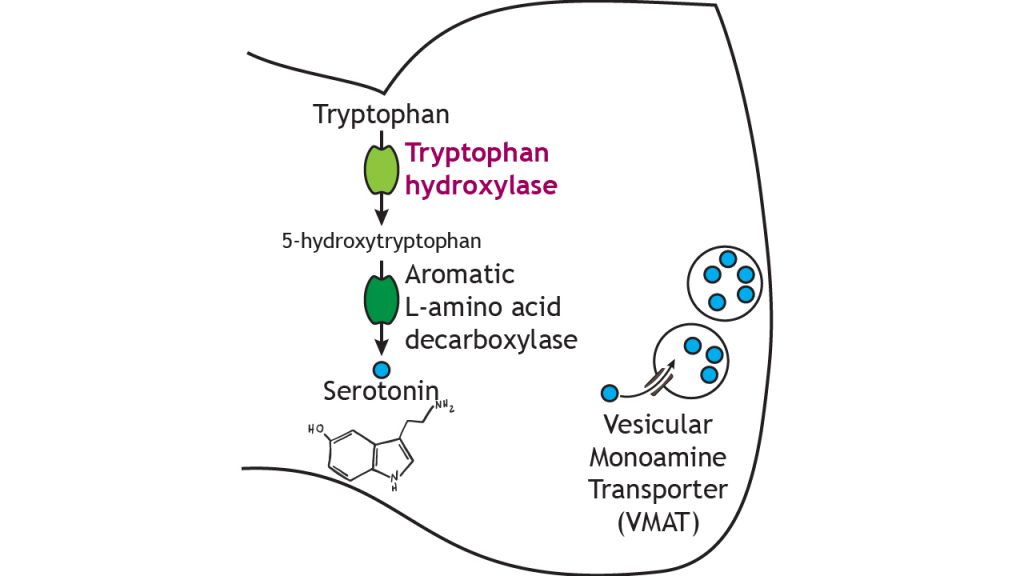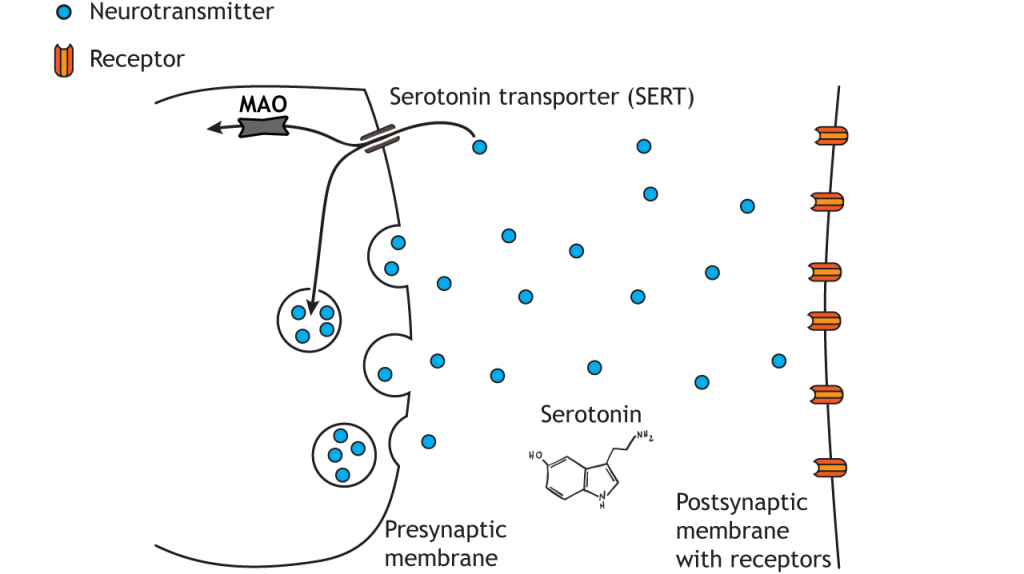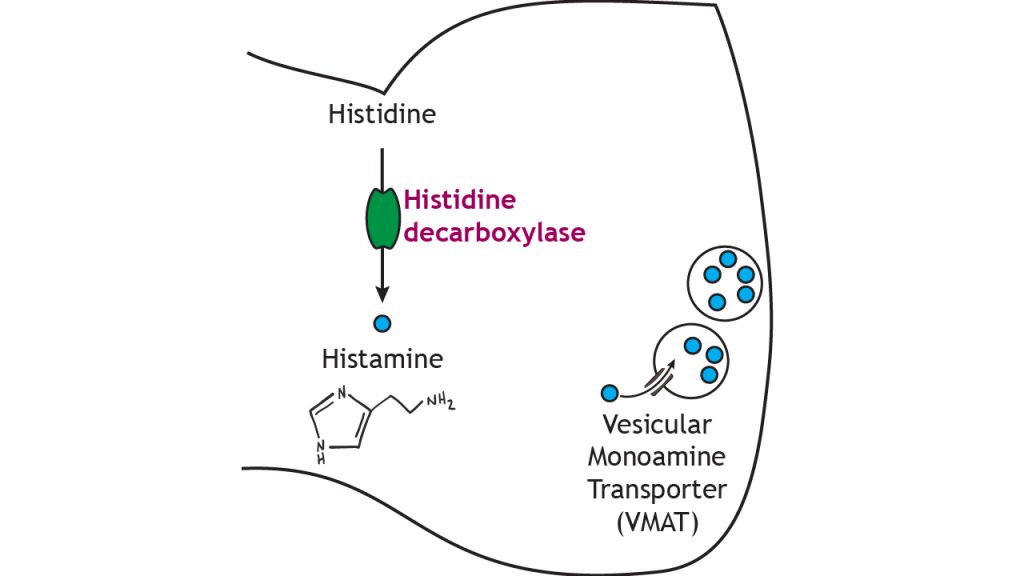17 Neurotransmitters: Biogenic Amines (Serotonin, Histamine)
The biogenic amines encompass multiple neurotransmitters, including serotonin, histamine, dopamine, norepinephrine, and epinephrine. Included within the biogenic amines is a separate group of neurotransmitters, the catecholamines.
This chapter will provide information for only serotonin and histamine. Catecholamines are covered in the following chapter.
Serotonin
Serotonin, a biogenic amine neurotransmitter, is known for its role in mood. As with dopamine (another monoamine neurotransmitter), there are only a few areas of the brain that synthesize serotonin, the major one being the Raphe nucleus in the brain stem.
Synthesis
The enzyme tryptophan hydroxylase is the first step of serotonin biosynthesis, converting the amino acid tryptophan into 5-hydroxytryptophan and is often used as a marker to identify serotonergic neurons. This is also the rate-limiting step of the synthesis pathway. Then aromatic L-amino acid decarboxylase converts the 5-hydroxytryptophan into serotonin. Serotonin is packaged into small vesicles by the vesicular monoamine transporter similar to the other monoamine neurotransmitters: dopamine, norepinephrine, and epinephrine.
 Figure 18.1. Serotonin is synthesized in a two-step process. Tryptophan is converted into 5-hydroxytryptophan by tryptophan hydroxylase, the rate-limiting step in the pathway. Then serotonin is synthesized from 5-hydroxytryptophan by aromatic L-amino acid decarboxylase. Serotonin is then packaged into vesicles by vesicular monoamine transporter. ‘Serotonin Synthesis’ by Casey Henley is licensed under a Creative Commons Attribution Non-Commercial Share-Alike (CC BY-NC-SA) 4.0 International License.
Figure 18.1. Serotonin is synthesized in a two-step process. Tryptophan is converted into 5-hydroxytryptophan by tryptophan hydroxylase, the rate-limiting step in the pathway. Then serotonin is synthesized from 5-hydroxytryptophan by aromatic L-amino acid decarboxylase. Serotonin is then packaged into vesicles by vesicular monoamine transporter. ‘Serotonin Synthesis’ by Casey Henley is licensed under a Creative Commons Attribution Non-Commercial Share-Alike (CC BY-NC-SA) 4.0 International License.
Serotonin Receptors
Serotonin binds to many different classes of receptors, including both ionotropic and metabotropic receptors. Most of the serotonin receptors are metabotropic receptors that utilize G-proteins to cause the opening of ion channels, or alter the activity of phospholipase C or adenylyl cyclase. Due to the large number of different serotonin receptors, the effects of serotonin can vary depending on the properties of the postsynaptic receptor. Only one class of serotonin receptors are ligand-gated ion channels and utilize a direct mechanism of action.
Termination of Serotonin Signaling
Like the other monoamines, serotonin goes through reuptake and is transported back into the presynaptic terminal via the serotonin transporter (SERT). The difference between serotonin and the catecholamines dopamine, norepinephrine, and epinephrine is that monoamine oxidase is the only enzyme used for degradation.

Histamine
Finally, histamine is another biogenic amine transmitter that is synthesized from histidine through the action of histamine decarboxylase, the rate-limiting step of the pathway. Like the other monoamine neurotransmitters, it is packaged into small synaptic vesicles via the vesicular monoamine transporter.
Though histamine has known roles in the immune system with allergic reactions and the inflammatory response, this chemical can also act as a hormone and a neurotransmitter within the central nervous system.
 Figure 18.4. Histamine is synthesized from histadine by histadine decarboxylase, the rate-limiting step in the pathway. Histamine is then packaged into vesicles by vesicular monoamine transporter. ‘Histamine Synthesis’ by Casey Henley is licensed under a Creative Commons Attribution Non-Commercial Share-Alike (CC BY-NC-SA) 4.0 International License.
Figure 18.4. Histamine is synthesized from histadine by histadine decarboxylase, the rate-limiting step in the pathway. Histamine is then packaged into vesicles by vesicular monoamine transporter. ‘Histamine Synthesis’ by Casey Henley is licensed under a Creative Commons Attribution Non-Commercial Share-Alike (CC BY-NC-SA) 4.0 International License.
Key Takeaways
- Serotonin and histamine are both examples of biogenic amine neurotransmitters
- Serotonin and histamine have different synthesis pathways, but are both packaged into vesicles by the same protein, VMAT
- Serotonin binds to both ionotropic and metabotropic receptors
Test Yourself!
Attributions
Portions of this chapter were remixed and revised from the following sources:
- Foundations of Neuroscience by Casey Henley. The original work is licensed under a Creative Commons Attribution-NonCommercial-ShareAlike 4.0 International License
- Open Neuroscience Initiative by Austin Lim. The original work is licensed under a Creative Commons Attribution-NonCommercial 4.0 International License.
Process where neurotransmitters are removed from the synapse and transported back into the presynaptic cell to be re-packaged into synaptic vesicles

